Intel Core i7-11700K Review: Blasting Off with Rocket Lake
by Dr. Ian Cutress on March 5, 2021 4:30 PM EST- Posted in
- CPUs
- Intel
- 14nm
- Xe-LP
- Rocket Lake
- Cypress Cove
- i7-11700K
Gaming Tests: Gears Tactics
Remembering the original Gears of War brings back a number of memories – some good, and some involving online gameplay. The latest iteration of the franchise was launched as I was putting this benchmark suite together, and Gears Tactics is a high-fidelity turn-based strategy game with an extensive single player mode. As with a lot of turn-based games, there is ample opportunity to crank up the visual effects, and here the developers have put a lot of effort into creating effects, a number of which seem to be CPU limited.
Gears Tactics has an in-game benchmark, roughly 2.5 minutes of AI gameplay starting from the same position but using a random seed for actions. Much like the racing games, this usually leads to some variation in the run-to-run data, so for this benchmark we are taking the geometric mean of the results. One of the biggest things that Gears Tactics can do is on the resolution scaling, supporting 8K, and so we are testing the following settings:
- 720p Low, 4K Low, 8K Low, 1080p Ultra
For results, the game showcases a mountain of data when the benchmark is finished, such as how much the benchmark was CPU limited and where, however none of that is ever exported into a file we can use. It’s just a screenshot which we have to read manually.
If anyone from the Gears Tactics team wants to chat about building a benchmark platform that would not only help me but also every other member of the tech press build our benchmark testing platform to help our readers decide what is the best hardware to use on your games, please reach out to ian@anandtech.com. Some of the suggestions I want to give you will take less than half a day and it’s easily free advertising to use the benchmark over the next couple of years (or more).
As with the other benchmarks, we do as many runs until 10 minutes per resolution/setting combination has passed. For this benchmark, we manually read each of the screenshots for each quality/setting/run combination. The benchmark does also give 95th percentiles and frame averages, so we can use both of these data points.
| AnandTech | Low Resolution Low Quality |
Medium Resolution Low Quality |
High Resolution Low Quality |
Medium Resolution Max Quality |
| Average FPS | 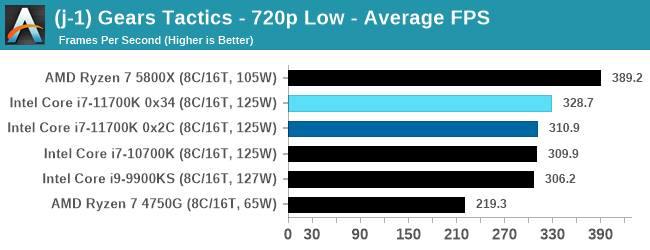 |
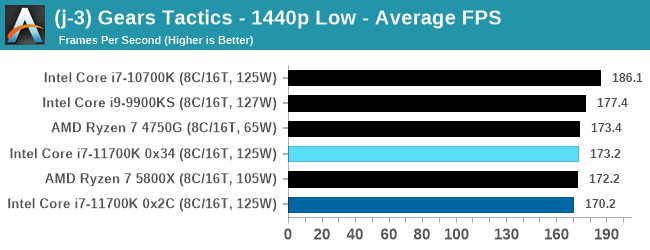 |
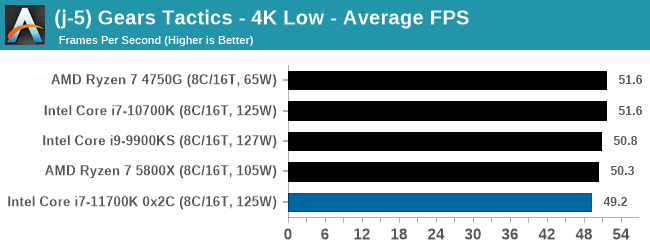 |
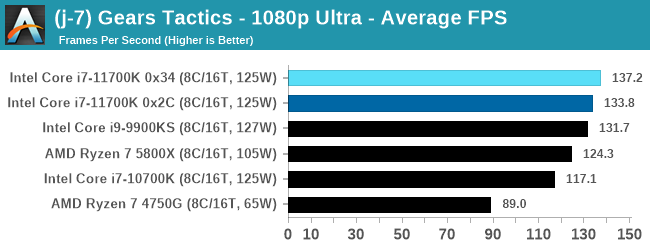 |
| 95th Percentile | 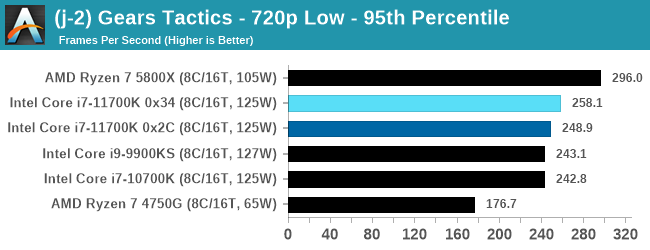 |
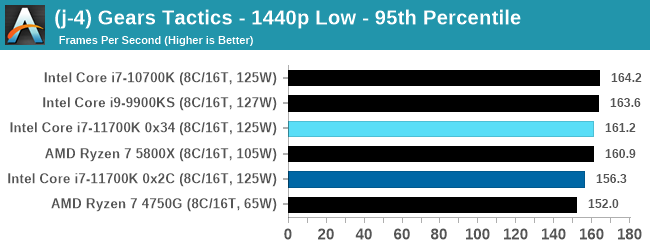 |
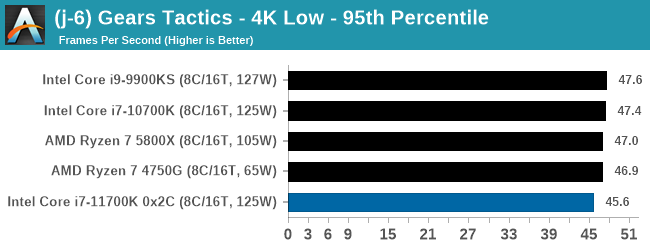 |
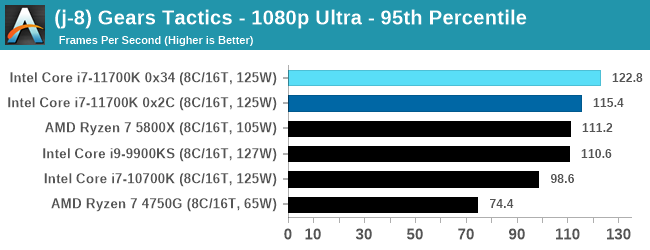 |
Gears is the one test where at our 1080p Maximum settings it shines ahead of the pack. Although at high resolution, low quality, although all five CPUs are essentially equal, it still sits behind AMD's Ryzen APU.
All of our benchmark results can also be found in our benchmark engine, Bench.


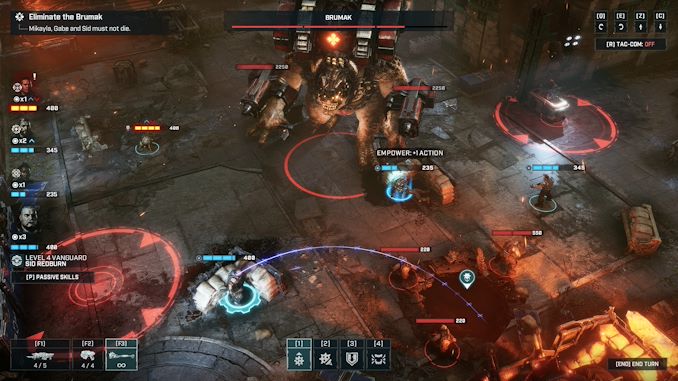









541 Comments
View All Comments
GeoffreyA - Tuesday, March 9, 2021 - link
Cage of their own making: I like that phrase. Well, I think for Intel, the best path is to design a microarchitecture from scratch, which I'm sure they're doing. Possibly Intel Israel. Sunny Cove, descending all the way from P6, is not holding up any more.Zim - Sunday, March 7, 2021 - link
Time to be me some more AMD stock.alhopper - Sunday, March 7, 2021 - link
What an awesome deep-dive technical expose/review of this processor. No stone left un-turned - incredibly detailed investigation and easily understood explanations. With this level of detail every reader can make up their own mind about the pros/cons of this product - there's no need for me to offer an opinion.Many thanks for this well written treasure trove of technical information and the graphics are wonderful. Kudos to the entire team and keep up the Good Work (TM) !!
poohbear - Sunday, March 7, 2021 - link
Wow how the tables have turned. I remember for AMD's Bulldozer review, which was supposed to be AMD's answer to Core, Bulldozer was similar to Rocket Lake...it consumed MORE power and was SLOWER than the competition. Well, here's to Intel making a comeback with Alder Lake, but 2021 clearly belongs to AMD.Hifihedgehog - Monday, March 8, 2021 - link
Alder Lake, just confirmed in a lineup leak to use a heavy amount of little or low power cores, first has to ensure that they get heterogenous core architecture working in the Windows scheduler. The biggest roadblock Microsoft claimed to have already fixed it with Lakefield but even after they did and additionally Cinebench, per Intel’s special emergency request, to recompile a special update to R20 after that, Lakefield was an absolute failure in performance compared to a Y-class (or M notated) Core product. Personally, I have little faith in Microsoft and I also do not expect software companies recompiling every last piece of software made in the last decade either just to accommodate a radical new design all for Intel’s sake. Developers would much rather assume a simple, vanilla core architecture than an unbalanced one with little and big cores and therein lies a huge risk factor for Intel. I foresee a huge misfire here because Microsoft isn’t exactly a good company to bet on refixing what they claimed they have already fixed with Lakefield.GeoffreyA - Monday, March 8, 2021 - link
I'm sceptical of this whole fast/slow core approach myself and believe it's a mistake. They will learn the hard way. Perhaps it works for Apple, I don't know, but Intel and AMD are better of spending their efforts in cutting down power in their ordinary cores dynamically.Hifihedgehog - Monday, March 8, 2021 - link
It works for Apple because they have a iron-tight grasp on the full stack which requires developers to use their latest compilation and development tools to get their apps to the App Store and ultimately in users’ hands. You can run pretty much anything under the sun for 2 decades plus on Windows and without a recompile, you will never utilize their cores correctly. The Windows scheduler as it stands is garbage tier compared to Linux with a plain vanilla homogenous core design so I expect very little from Microsoft unless they actually redesign their scheduler from the ground up. Don’t hold your breath on that one.GeoffreyA - Monday, March 8, 2021 - link
The whole idea smacks of Bulldozer, and that means disaster.blppt - Monday, March 8, 2021 - link
Only if their single thread performance sucks (which from all I've seen, it won't)---Bulldozer's problem was being behind in manufacturing process and requiring a highly-threaded application to shine.Hifihedgehog - Tuesday, March 9, 2021 - link
Well, the problem then is how smartly it assigns threads to the right cores and the Windows scheduler still has serious problems with that to this very day. If it doesn’t do that right, it could appear like an overclocked Core i3 in comparison to Ryzen and that is where the Bulldozer analogy is fitting. AMD banked on their unique topology getting OS and development optimization down the road—FineWine to coin a phrase—but that never materialized.